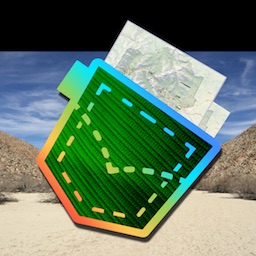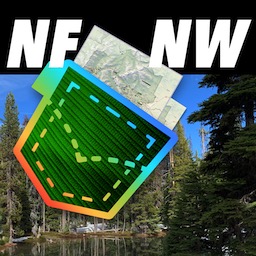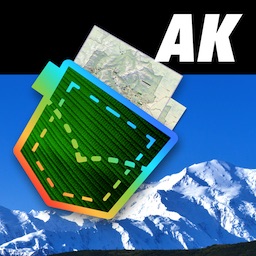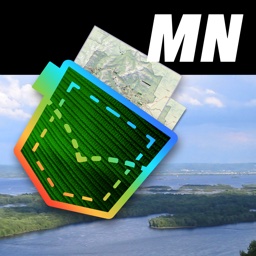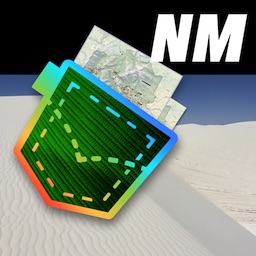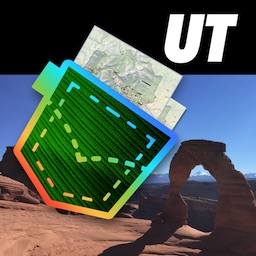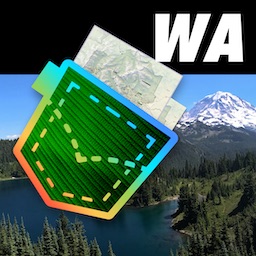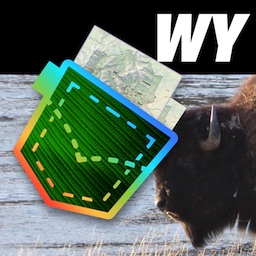"Autumn - Heintooga Ridge Road" by U.S. National Park Service , public domain
Great Smoky MountainsGuide Spring 2020 |
featured in
| National Parks Pocket Maps |  | |
| North Carolina Pocket Maps |  |
covered parks
SMOKIES GUIDE
The official newspaper of Great Smoky Mountains National Park • Spring 2020
In this issue
Smokies Trip Planner • 2
Return of Fireflies • 4
National Park News • 5
Safety in the Mountains • 6
Spring Driving Map • 8
Jr. Ranger Corner • 10
How to Help the Smokies • 11
Bears Emerge • 12
Park Etiquette • 14
Visitor Information • 16
The Blue Ridge two-lined salamander’s (Eurycea wilderae) larvae are aquatic, living in streams and under rocks. Image courtesy of John P. Clare
Moving Rocks Harms Aquatic Wildlife!
ge
an
n
ian
Jul
eG
r
Biodiversity thrives beneath the surface of Smokies streams
kR
e le
ar
P
ynse
, Education
Words with a Ranger
My childhood was spent playing and
fishing in the lakes and rivers of the
Midwest. With more than 2,000 miles
of streams flowing from the mountains to the valleys of Great Smoky
Mountains National Park, it’s easy to
feel at home here.
As an education park ranger, part of
my job is to educate park visitors about
the cultural and natural resources in the
park and how to protect them. With
more than 12 million visitors annually,
the resources can sometimes be damaged, often unintentionally.
Words with a Ranger continued on page 5
S
pring is finally here! And as temperatures and humidity rise, visitors are
tempted to dip their toes—and more—in
the cool waters of the park’s 2,900 miles of
clear mountain streams.
The Smokies’ streams are fed by tens of
thousands of rain-fed springs, constantly
trickling water from crevices in the ancient
mountain range. Residing beneath the
surface is everything from native brook
trout to 11 species of crayfish to 15 species
of salamanders. These creatures currently
face a huge threat—from some of the visitors who come to enjoy the park!
“This time of year, people begin to stack
rocks and create ‘cairns,’ channels, and rock
dams in the park’s streams and creeks,” said
Park Ranger Julianne Geleynse. “Many
salamander and fish species lay their eggs
under rocks of various sizes. The movement
OUR PARK
ON SOCIAL MEDIA
or removal of these rocks disrupts breeding
behavior and can completely destroy the
nest and eggs of both salamanders and fish.”
People visit the Smokies to escape the
modern world—yet rock cairns, dams, and
channels are evidence of human disturbance, changing the park’s wilderness character that now draws 12.5 million visitors
each year.
“When rocks are moved, the water
temperature, flow, and dissolved oxygen
are altered, completely changing the
habitat and disrupting the aquatic life,”
Geleynse said. “Some species of aquatic
insects are immobile and die once
removed from the stream.”
Moving rocks poses a great threat in
particular to aquatic wildlife like eastern
hellbenders, endangered Smoky Madtoms,
and Citico Darters.
GreatSmoky
MountainsNPS
HOW CAN YOU
ENCOURAGE OTHERS
TO PREVENT
MOVING ROCKS?
Share positive messaging
on how to protect aquatic life
through your social media
outlets. Parents and children
can encourage each other
to respect park streams and
leave no trace.
GreatSmokyNPS
and SmokiesRoadsNPS
GreatSmokyNPS
SMOKIES TRIP PLANNER
Camping in the national park
The National Park Service maintains
developed campgrounds at nine locations in the park. Only Cades Cove and
Smokemont are open in winter. There
are no showers or hookups other than
circuits for special medical uses at Cades
Cove, Elkmont, and Smokemont.
Campsite reservations are required at
Abrams Creek, Balsam Mountain, Big
Creek, and Cataloochee campgrounds.
Reservations also may be made at Cades
Cove, Cosby, Elkmont, and Smokemont.
Sites may be reserved up to six months
in advance. Make your reservation at
recreation.gov or call 877.444.6777.
Site occupancy is limited to six
people and two vehicles (a trailer = one
vehicle). The maximum stay is 14 days.
Special camping sites for large groups
are available seasonally at Big Creek,
Cades Cove, Cataloochee, Cosby, Deep
Creek, Elkmont, and Smokemont.
Group sites must be reserved and may be
secured up to a year in advance.
Maps and guides: SmokiesInformation.org Additional information: nps.gov/grsm
The list below shows number of sites,
elevations, opening dates, nightly fees,
and maximum RV lengths. For more
information, visit nps.gov/grsm.
Bicycles are permitted on park roads
but prohibited on trails except Gatlinburg, Oconaluftee River, and lower
Deep Creek/Indian Creek.
• Abrams Creek 16 sites, elev. 1,125',
opens April 24, $17.50, 12' trailers
• Balsam Mountain 42 sites, elev. 5,310',
opens May 15, $17.50, 30' RVs
• Big Creek 12 sites, elev. 1,700', opens
April 3, $17.50, tents only
• Cades Cove 159 sites, elev. 1,807',
opens March 6 after tunnel repairs this
winter, $21-$25, 35'-40' RVs
• Cataloochee 27 sites, elev. 2,610',
opens June 11, $25, 31' RVs
• Cosby 157 sites, elev. 2,459', opens
April 3, $17.50, 25' RVs
• Deep Creek 92 sites, elev. 1,800',
opens May 21, $21, 26' RVs
• Elkmont 220 sites, elev. 2,150', open,
$21-$27, 32'-35' RVs
• Smokemont 142 sites, elev. 2,198',
open year-round, $21-$25, 35'-40' RVs.
• Look Rock closed in 2020
Accommodations
• LeConte Lodge (accessible by trail
only) provides the only lodging in the
park. 865.429.5704 or lecontelodge.com
Firewood
To prevent the spread of destructive
insect pests, the NPS has banned outside
firewood from entering the park unless it
is USDA- or state-certified heat-treated
wood. Campers may gather dead and
down wood for campfires. Certified
wood may be purchased in and around
the park.
MOVING ROCKS
HARMS
AQUATIC LIFE.
SMOKIES GUIDE
Smokies Guide is produced five times per year by
Great Smoky Mountains Association and Great
Smoky Mountains National Park.
nps.gov/grsm
SmokiesInformation.org
Bicycling
Most park roads are too narrow and
heavily traveled by automobiles for safe or
enjoyable bicycling.
Helmets are required by law for
persons age 16 and under. However,
helmets are strongly recommended for
all bicyclists.
Publication dates are
roughly as follows:
Spring: mid-March
Summer: early June
Late Summer:
mid-August
Autumn: mid-Sept.
Winter: mid-Dec.
Editor
Frances Figart
For information on lodging outside
the park:
• Bryson City 800.867.9246 or
greatsmokies.com
• Cherokee 828.788.0034 or
cherokeesmokies.com
• Fontana 800.849.2258 or
fontanavillage.com
• Gatlinburg 800.588.1817 or
gatlinburg.com
• Maggie Valley 800.624.4431 or
maggievalley.org
• Pigeon Forge 800.251.9100 or
mypigeonforge.com
• Sevierville 888.766.5948 or
visitsevierville.com
• Townsend 800.525.6834 or
smokymountains.org
Pets in the park
Pets are allowed in front-country campgrounds and beside roads as long as they
are restrained at all times. Pets are not
allowed on park trails, except for the
Gatlinburg and Oconaluftee River Trails.
Dogs on these trails must be leashed.
Special events
April 22–25, 2020 Spring Wildflower
Pilgrimage: parkwide
May 5–9, 2020 Wilderness Wildlife
Week: parkwide
June 20, 2020 Women’s Work
Mountain Farm Museum
Writers
Valerie Polk
Aaron Searcy
Design Assistants
Lisa Horstman
Emma DuFort
Lead Designer
Karen Key
NPS Coordinator
Susan Sachs
Smokies Guide Spring 2020 • 2
For rent
The Appalachian Clubhouse and Spence
Cabin at Elkmont can be rented for
daytime events starting April 1. Contact
recreation.gov.
Visitor centers
Spring hours of operation are
Oconaluftee and Sugarlands: 8-5 in
March; 8-6 in April and May. Cades
Cove: 9-6 in March; 9-6:30 in April;
9-7 in May. Clingmans Dome (opens
March 30): 10-6.
Picnic areas
Picnic areas open year-round are:
Cades Cove, Deep Creek, Greenbrier,
and Metcalf Bottoms. Chimneys Picnic
Area opens March 13. Picnic areas
opening April 3 include Big Creek,
Collins Creek, and Cosby. Look Rock
Picnic Area opens May 1 and Heintooga
Picnic Area opens May 15. Please see
the map on page 16 for locations. Picnic
pavilions may be reserved for $12.50$80 at recreation.gov.
Other services
There are no gas stations, showers, or
restaurants in the national park.
Park weather
• Spring - March has the most
changeable weather; snow can fall
on any day, especially at the higher
elevations. Backpackers are often caught
off guard when a sunny day in the
70s°F is followed by a wet, bitterly cold
one. By mid- to late April, the weather
is milder.
• Summer - By mid-June, heat, haze and
humidity are the norm. Most precipitation occurs as afternoon thundershowers.
Planning Committee
PT Lathrop
Lisa Nagurny
Becky Nichols
Bill Stiver
Paul Super
Stephanie Sutton
© 2020 Great
Smoky Mountains
Association
P.O. Box 130
Gatlinburg, TN 37738
E Printed on
recycled paper
• Autumn - In mid-September, a pattern
of warm, sunny days and crisp, clear
nights often begins. However, cool, rainy
days also occur. Snow may fall at the
higher elevations in November.
snowy with highs in the 20s. At
the low elevations, snows of 1" or
more occur 3-5 times per year. At
Newfound Gap, 69" fall on average.
Lows of -20°F are possible at the
higher elevations.
• Winter - Days during this fickle
season can be sunny and 65°F or
Fishing
Fishing is
permitted yearround in the
park, and a
Tennessee or
North Carolina
fishing license is
required. Either
state license is
valid throughout
the park, and no
trout stamp is
required. Fishing
with bait is
prohibited in
the park. A
special permit
is required for
the Cherokee
Reservation
and Gatlinburg. Licenses
are available in
nearby towns.
These temperature
and precipitation
averages are
based on data for
the last 20 years.
Temperatures
are in degrees
Fahrenheit. An
average of over
84" (7 feet) of
precipitation falls
on the higher
elevations of the
Smokies. On Mt.
Le Conte, an
average of 82.8" of
snow falls per year.
A free fishing map with a complete
list of all park fishing regulations is available at visitor centers.
wet (not cotton). Be prepared for
sudden weather changes, especially at
the higher elevations. Stay dry.
Camping in the backcountry
Springtime camping can be an exciting
adventure for persons properly equipped
and informed. To facilitate this activity,
the National Park Service maintains
more than 800 miles of trails and more
than 100 backcountry campsites and
shelters throughout the park. One of
the greatest challenges for backcountry
campers is deciding where to go. Here
are some tools to help.
1. Get the map. Go online to view
the park’s official trail map (nps.gov/
grsm/planyourvisit/maps.htm), which
shows all park trails, campsites, and
shelters. Park rules and regulations are
also listed here. If you wish, you can
purchase the printed version of the trail
map for $1 by stopping at any park
visitor center or calling 865.436.7318
x226 or shopping online at
SmokiesInformation.org.
2. Plan your trip. Call or stop by
the park’s backcountry office, which is
open daily from 8 a.m. to 5 p.m, for
trip planning help. The office is located
in Sugarlands Visitor Center, two miles
south of Gatlinburg on U.S. 441.
865.436.1297.
3. Get a permit. Make your reservation and obtain your permit through
the backcountry office at Sugarlands
Visitor Center (by phone or in person)
or online at smokiespermits.nps.gov.
Reservations and permits are
required for all overnight stays in the
backcountry. The cost is $4 per person
per night. Reservations may be made
up to 30 days in advance.
Spring hikers should be especially
aware of the danger of hypothermia—
the lowering of body temperature. The
combination of rain, cold, and wind
is especially dangerous. At the park’s
higher elevations, hypothermia can be a
threat even during summer.
To prevent hypothermia, carry
reliable rain gear at all times. Layer
clothing that provides warmth when
Road Closures
Many secondary and higher elevation
roads are closed in winter and open
later into spring. Please refer to the map
on pages 8 and 9 for opening dates for
Clingmans Dome and other seasonally
closed roads.
Road access to the Cataloochee area
is closed through May 20 for NC Dept.
of Transportation road repairs.
Smokies Guide Spring 2020 • 3
Driving distances and
estimated times
Cherokee, NC to:
Gatlinburg: 34 miles (1 hour)
Cades Cove: 58 miles (2 hours)
Newfound Gap: 18 miles
(½ hour)
Clingmans Dome: 25 miles
(¾ hour)
Cataloochee: 39 miles
(1½ hours)
Deep Creek: 14 miles (½ hour)
Gatlinburg, TN to:
Cherokee: 34 miles (1 hour)
Cades Cove: 27 miles (1 hour)
Newfound Gap: 16 miles
(½ hour)
Clingmans Dome: 23 miles
(¾ hour)
Cataloochee: 65 miles
(2½ hours)
Greenbrier Cove: 6 miles
(¼ hour)
Deep Creek: 48 miles
(1½ hours)
Townsend, TN to:
Cades Cove: 9 miles (¼ hour)
Newfound Gap: 34 miles
(1¼ hours)
Gatlinburg: 22 miles (¾ hour)
Cherokee: 52 miles (1½ hours)
Look Rock: 18 miles (½ hour)
Cataloochee: 87 miles (3 hours)
Smokies Glow
with the Return of Fireflies
Photinus carolinus lights up the Smokies’ night skies
TH E F I R E F LY
LOT TE R Y
T
he Smokies are world famous for their fireflies, and
one species in particular, Photinus carolinus, puts on
a particularly spectacular display. Of the 19 species of
fireflies known to light up the night in the Smokies, P.
carolinus is the only one with a synchronized light show.
Fewer than 1 percent of some 2,000+ distinct firefly
species are known to flash synchronously as part of their
mating display. The bioluminescence common to fireflies
helps males and females recognize each other at dusk.
As word of the Smokies’ synchronous fireflies has spread,
the Elkmont area has implemented a lottery and shuttle
system to ensure resources are protected and viewers have a
safe and enjoyable experience. The timing of viewing events
relies on a firefly prediction system carefully managed by
park entomologist Becky Nichols.
Firefly habitats include tall grasses and open-cove forests,
both of which have been dramatically reduced by human
development. Fireflies also need darkness free of light pollution. Even flashlights and headlights can cause fireflies to
stop flashing completely for several minutes at a time.
You can help protect fireflies and enjoy the show too with
the viewing tips below:
• Let fireflies shine as they are and do not catch or
collect them.
• Keep light to a minimum—use a red-tinted light and
keep it pointed toward the ground to reduce light pollution.
Firefly-safe lights are available at park visitor centers.
• Pack out all garbage and stay on trails at all times—
firefly larvae and vegetation can be crushed by even the most
well-intentioned footsteps.
Smokies Guide Spring 2020 • 4
The Elkmont area is open
only to campers and shuttle-bus riders during the
peak of the synchronous
firefly display. To enter the
lottery, visit recreation.
gov and search “firefly
event lottery.” Winners will
receive a firefly-safe light
and a one-night park-andride pass for a $25 fee. For
additional information,
visit nps.gov/grsm.
Park partner Discover Life
in America is also offering
exclusive guided viewing
opportunities at a location
outside of the park on
May 29, 30, and 31. Tickets
are $225 per person, and
all proceeds support DLiA’s
work to discover and conserve Smokies biodiversity.
For details, see dlia.org/
event/fireflies-2020.
Words with a Ranger
continued from page 1
In recent years, visitors have
moved rocks to create dams,
channels, and cairns to such an
extent that it has changed the
aquatic habitat, leading to the
death of thousands of aquatic
animals. Salamanders, fish, and
dragonfly larvae are just a few
of the creatures that make their
homes and nests under the
rocks in the streams. Species
like the eastern hellbender
are so rare that the streams in
the park are some of the last
places they can be found. To an
aquatic animal, moving rocks
is like cutting down a tree that
supports a bird’s nest. It harms
the adults, eggs, and young.
What can you do? Leave no
trace, so future generations are
able to enjoy the park and all
the species that call it home.
Share with others how they
can help to protect the park.
Thank you for not moving
rocks and sharing this message
with your friends and family.
PARK NEWS
Great Smoky Mountains National Park news briefs
Cades Cove Access Update
The Cades Cove area is now open to all visitors via Laurel Creek
Road from the Townsend Wye entrance to Great Smoky Mountains National Park.
Visitors to the popular Cades Cove Loop Road this spring
can expect greening fields, emerging wildlife, blooming wildflowers, and flowering trees. Camping and picnic areas are also
available in the area known for its historic structures and hikes to
nearby destinations including Abrams Falls and Gregory Bald.
Cades Cove was closed to visitor traffic over the winter due
to scheduled repairs to the Bote Mountain Tunnel in January
and February 2020. The decision to close this area of the park
completely to accommodate the repair was reached through NPS
assessment and with the input of community leaders in favor of
avoiding prolonged lane closures throughout 2020. The necessary
Two gravel roads, Sparks Lane and Hyatt Lane, connect the north
and south sides of the 11-mile, one-way Cades Cove Loop Road.
Allow at least two to four hours to tour Cades Cove, longer if you
walk some of the area’s trails. Image courtesy of Diego Ferron
updates to the 72-year-old Bote Mountain Tunnel include repaired
cracks in the concrete liner and replaced drainage features.
Such repairs are a necessary part of maintaining aging facilities in the Smokies and across the national park system, much
of which is currently impacted by the estimated $12 billion in
deferred maintenance to national park infrastructure as a result of
increasing demand and limited resources.
As visitation continues to break records in the Smokies, projects like the Bote Mountain Tunnel repair will help make sure
the Smokies continue to be safe and accessible for years to come.
Cherokee Sochan Agreement Enters First Full Season
This spring marks the first full harvesting season
since the Eastern Band of Cherokee Indians (EBCI)
and the National Park Service finalized a landmark
agreement to allow a limited number of permitted
EBCI members to harvest sochan for traditional
food purposes within Great Smoky Mountains
National Park (GSMNP).
Sochan, or green-headed coneflower (Rudbeckia laciniata), is a culturally significant food
of the Cherokee, and going to the mountains to
gather its young leaves is a family tradition considered by some to be sacred. The tall, late-summer-blooming wildflower is common along
streams and wet areas throughout the park.
“It was a great opportunity to collaborate
with the EBCI on this project,” said Josh Albritton, a park bio-science technician. “Maintaining
long-standing cultural values and traditions is
important for all of us, and this is certainly an
opportunity to do just that.”
Despite a delayed start last year, the first harvest
“went very smoothly,” said Albritton. “All sochan
harvesting and reporting by EBCI permittees went
according to the guidelines.”
This year, park staff will continue to monitor
designated sochan populations and assess other
plants EBCI members may wish to harvest. “I
think everyone involved is looking forward to the
coming season,” said Albritton.
With the exception of such permits, federal law
protects almost everything in national parks, including wildlife, plants, historic objects, and even rocks.
Exceptions include game fish (with catch limits) and
berries, nuts, and edible mushrooms (for personal
consumption only).
Smokies Guide Spring 2020 • 5
Green-headed coneflower, or sochan, is known for its showy
late-summer blooms, but it is the young spring leaves,
emerging well before the flowers, which are sought by the
Cherokee as a favorite spring green. Image courtesy of GSMA.
Setting Out for the S
Mountains...Safely
It is your responsibility to be safe and
to know and obey park rules. You can
find information and rules at visitor
centers, trailhead bulletin boards, and
the park website at nps.gov/grsm.
B A S I C PAC K L I S T
• Water, a water filter, tablets, or the ability
to boil water
• Food and plenty of snacks will sustain you
• Extra layers (base layer, jacket, socks) for
changing conditions
• Sun protection with sunscreen, sunglasses,
and/or a hat
• Rain gear
• Pack cover to keep what you are carrying dry
(ziplocs inside your pack can do this too)
• Map and compass and the knowledge of
how to use them
• Shelter in the form of a tent or tarp
• Flashlight or headlamp and batteries
• Fire starter with a lighter, strike stick, and
something to light
• Knife or multi-tool for a variety of uses
• First aid kit with all the essentials to care
for common accidents
• Permit for camping overnight (provide
itinerary so the NPS knows where to
begin looking for you in an emergency)
pring is a great time to get out and explore
Great Smoky Mountains National Park.
As you plan, it’s important to remember that
the season also brings with it some of the most
unpredictable weather and rapidly changing
conditions of the year.
Be sure to make responsible planning and safety
a priority, whether you’re setting out on a day hike,
packing for an overnight camping trip or taking in
the sights on a drive through the mountains.
“You might start out your hike on a clearblue-sky day and end up contending with cold
wind, rain, sleet, or snow,” said Backcountry
Management Specialist Christine Hoyer. “Even an
experienced hiker, park employee, or iPhone can’t
predict what Mother Nature has in store.”
After years of experience working in the backcountry and with Appalachian Trail thru-hikers,
Hoyer has arrived at a few basics for preventing
the worst. “What you carry and what kinds of
conditions you prepare for has nothing to do with
how far you plan to walk. I pack the same essentials in my backpack no matter what,” said Hoyer.
“Quality rain gear and appropriate warm layers are
a must—and not just wearing them but carrying
extras with you, too.”
Beyond bringing layers, Hoyer urges visitors to
pack ample water and food, sources of light and
fire, and a reliable means of navigation, since much
of the park is without cellular service.
Hikers and motorists should factor wind
advisories into their visits, too. As National
Weather Service reporting shows, extreme winds
are becoming more frequent in the Smokies. This
means the risk of injury from motor vehicle accidents and downed trees is only growing—particularly in burn-affected areas and in both high and
low elevations.
“During an extended wind event, mountain wave winds can have devastating impacts on
lower elevation areas as they make their way down
northern, leeward slopes,” said Jim Renfro, the
park’s air resource specialist. “That’s where you see
more trees coming down in areas like Cades Cove,
Sugarland Valley, or Greenbrier Cove.”
From planning ahead to being mindful of
emerging wildlife and seasonal hazards, the most
important part of any trip in the great outdoors is
coming back safely.
“The best thing you can do is have a solid
plan and the willingness to adjust your plan if
you need to,” said Hoyer. “Take it slow—think
before you act.”
Smokies Guide Spring 2020 • 6
B E M I N D F U L O F:
• Lightning
• High winds
• Rapid changes in weather
• Emerging wildlife and black bears
• Poison ivy and brambles
• Slippery logs, rocks, and leaves
• Water-crossings (Water can rise quickly,
and rocks and logs near water are often
very slippery; closely supervise children
around all water)
• Drones are banned on all National Park
Service property, including the Smokies.
• Campfires are permitted only within fire
rings. Use only firewood purchased from
campgrounds; imported wood contains
dangerous and invasive pests. Do not
leave food or trash in fire rings.
• Pets are prohibited on all trails (except
Gatlinburg and Oconaluftee River trails)
to protect wildlife. Pets may be kept on a
leash at all times in campgrounds, picnic
areas, and along roads. Service animals
that have been individually trained to
perform specific tasks for the benefit of
persons with disabilities are allowed in
all visitor use areas.
• Metal detector use is prohibited.
• Take only pictures. It is illegal to take any
natural features including flowers, seeds,
rocks, antlers, or historical artifacts or to
disturb soils, rocks, or vegetation. Limited collection of some fish, berries, nuts,
and mushrooms is permitted.
• Pack out all trash and Leave No Trace to
help protect the Smokies.
Things to Do
There are so many ways to explore and learn about the Smokies
Historic Grist Mills
Two water-powered grist mills operate in
the park seven days per week from spring
through fall, demonstrating the historic
necessity of grinding corn into cornmeal.
Cable Mill, located near Cades Cove
Visitor Center, halfway around the Cades
Cove Loop Road, opens March 7.
Mingus Mill, located 2 miles north of
Cherokee, NC, near the Mountain Farm
Museum, opens April 1.
Junior Rangers
Kids 5-12—earn your Great Smoky
Mountains National Park Junior Ranger
badge today! Just stop by any park
visitor center and purchase the Junior
Ranger booklet ($2.50) appropriate
for your age. Complete the activities
described in the booklet and you’re on
your way to Junior Ranger glory.
Image of Mingus Mill by Jackie Novak
Quiet Walkways
These peaceful pathways are scattered
around the park offering visitors an
opportunity to step outside their vehicles
and soak in the Smokies’ lush and intricate beauty. Parking is limited to three
or four vehicles to keep the walkways
quiet. A few of the trails are short loops,
but most are linear trails inviting walkers
to go as far as they wish and then return
the way they came. Look for the Quiet
Walkways signs along many park roads.
Passport Stamps
Ready to have your official Passport to
Your National Parks® stamped? You’ll
find free site-specific stampers at all park
visitor centers and some campgrounds.
If you don’t have one, pick up this
collector’s edition book in one of the
park’s visitor centers!
Image by Bill Lea
Field to Fork Audio Tour
The National Park Service and Great Smoky Mountains Association
have partnered with Antenna Audio to create a compelling tour of the
Mountain Farm Museum at Oconaluftee (2 miles north of Cherokee,
NC). You’ll learn how hard-working farm families scratched a living
from the steep, rocky soils of the Smoky Mountains and lived a rich and
happy life while doing so. Image by GSMA
Self-guiding Tours
Want to know a little about the sights
you are seeing? Nonprofit park partner
Great Smoky Mountains Association
has published a series of colorful,
inexpensive booklets keyed to numbered posts along park roads. You’ll
learn about park history as well as some
of the plants and wildlife you’ll encounter along the route. Self-guiding tour
booklets are available at park visitor
centers as well as dispensers beside the
roads. Tours include: Cades Cove
driving and walking, Roaring Fork
Motor Nature Trail, the Mountain
Farm Museum, Newfound Gap Road,
Tremont Logging History, and
Mingus Mill. Image of Cades Cove (left)
by Bill Lea
Smokies Guide Spring 2020 • 7
In addition,
stop in at any
visitor center and
get information
about current ranger
programs happening
in the park!
To Knoxville
In Spring,
Timing is
Everything
To I-40
To Newport
ay
Exit
443
Hartford
CHEROKEE NATIONAL FOREST
Exit
447
Park View
411
441
PIGEON FORGE
Roaring Fork Motor Nature Trail:
Paved, narrow, 5.5 mile one-way road
offers old-growth forest, waterfalls
and historic buildings. No RVs allowed.
Opens April 10.
Gatlinburg Welcome Center
National Park
Information Center
321
Pittman
Center
73
321
Cosby
Hen Wallow Falls
a il
321
Exit 451
32
Gab
TENNESSEE
N OR TH C AROL
I
Mount
Cammerer
Mount
Cammerer
Trail
Big
Creek
NA
40
Tr
MARYVILLE
es M ounta i n
i
ch
ala
Andrews Bald
at
i
Ro
Tw e n
ty m
Twentymile
Cascade
Fontana
Dam
Fontana
A
Lake
Trail
Cre
441
Restrooms are available
at visitor centers, Cades Cove and
Smokemont campgrounds, Cades Cove,
Deep Creek and Greenbrier picnic areas,
Newfound Gap and Great Smoky Mountains
Institute at Tremont. Vault toilets are
also available at Rainbow Falls, Alum Cave,
Abrams Falls and Clingmans Dome trailheads.
Loop
Trail
Juney Whank Falls
La
ke
vie
Juney Whank
Falls Trail
wD
Indian
Creek Falls
Tom Branch Falls
CHEROKEE
H
RT
al a
g
e R id
e
Parkw
ay
CHEROKEE INDIAN RESERVATION
Soco Gap
Cherokee Museum
Horseback Riding
(rental)
Picnic Areas
Major Hwys
Deep Creek
Major Roads
441
Paved Roads
Gravel Roads
74
Trails
Spring Auto Tours
23
74
SYLVA
143
28
WAYNESVILLE
NANTAHALA
NATIONAL
FOREST
441
23
Great Mountain Views
Wildflowers
B
w
ar k
id ge P
lue R
©GSMA2019
Dellwood
Nature Trails
Trail
Santeetlah
Lake
129
Maggie
Valley
To
Asheville
Camping
n
JOYCE
KILMER - SLICKROCK
WILDERNESS AREA
276
19
r
Swain County
Visitor Center
28
ch
Blu
ia
NO
Ap p
Mingo
Falls
19
BRYSON
CITY
FONTANA
VILLAGE
Balsam
Mountain
ad
Oconaluftee River
Trail
Deep
eT
ra i
l
Hazel Creek
Trail
Exit 20
ek
Bone Valley
Trail
Heintooga/Round Bottom Road:
Opens May 15.
H
Smokemont
Oconaluftee Mill
Visitor Center
Cataloochee
PISGAH
Valley
Overlook NATIONAL
FOREST
Co
ve
Ro Cre
ad ek
Smokemont
Loop
Trail
Co
ve
PA R K
Chasteen
Creek Falls
Bi g
Clingmans Dome Road: 7-mile
paved road leads to the Clingmans
Dome trailhead. A very steep, halfmile walk takes you to Clingmans
Dome tower and the highest point
in the Smokies (6,643’).
Opens March 30.
Kan
nd Bot
ou
a/R
og
o
t
in
He
Newfound Gap Road: This paved
road is the only route over the Great
Smoky Mountains. It stretches
for 31 miles between Gatlinburg
and Cherokee and climbs from an
elevation of 1,300’ to 5,046’
(at Newfound Gap).
Kephart
Prong
Trail
Tr
R
n
un
t ai
Mo
Rich
Ap p
Newfound
Gap
rk
Par
k
(
R
O
N
LI
Charlies
Bunion
M O U N TA I N S
Thunderhead
Mountain
il
CA
TE
NN
E
Trail
Chimney
Tops Chimney Tops
Trail
N AT I O N A L
an
R
tooga idge Road
ein
SE
Wolf
Ridge
Trail
Lake
Cheoah
Alum Cave
Bluffs
Oconaluftee
Valley Overlook
SMOKY
Mount Guyot
tom Rd.
ES
Twentymile
Loop Trail
Deals
Gap
re
sC
ke
Fern Branch
Falls
Mouse
Creek
Falls
Cataloochee Valley
(closed through May 20):
8 miles from I-40 (including 3 miles
on a narrow gravel road). The short
road through the valley offers wildlife
viewing (including elk) and access to
a historic church, school and homes.
Mingus
129
Calderwood
Lake
p Trail
ek
T
Alum Cave
Trail
il
Tra
m
to
l e s)
hic
ve
Mount
Le Conte
r
ve
d
ed
b er Ga
re
Rainbow
Falls
Clingmans
Dome
Cades Cove Loop Road: 11-mile
one-way loop road offers wildlife
viewing and access to a historic grist
mill, churches and log homes.
Allow at least 2-3 hours.
ad
or
ot
cu m
Tri
lli u
bo
Tram Gap
il
Tra w F
a ll
il
s
Ri
tR
G R E AT
a
Appal chian Trail
s
clo
Ro
Ja
Lit
tle
Middle Prong
Trail
il
Tra
lls
Pa
n
r so
ch
Cu
Carlos
Campbell
Overlook
Ramsey
Cascades
Porters
Flat
Grotto
Falls
Road
Maloney
Point
Elkmont
GSM Institute
at Tremont
m
sF
a
Chilhowee
n
B ra
Little
Lynn Camp
Prong Cascades
Cades Cove
Visitor Center
CHEROKEE
NATIONAL
FOREST
Meigs
Falls
l
on
Ab
ra
Abrams
Falls
Abrams
Creek
“According to the National Phenology Network, trees in
our region are greening up 15 to 20 days earlier,” said
Paul Super, the park’s research coordinator. Caterpillars,
which dine voraciously on tree leaves, appear to be likewise emerging earlier.
Trail
Sugarlands
Visitor Center
il
ra
op Trai
ut T
stn
Ch e
Fighting Creek
Trail
Laurel
Falls Laurel Falls
r
Rive
Tre m
Look Rock
Tower
Little
Greenbrier
School
Po r t e r s C
o
Heritage
Center
ad
Cataract
Falls
Little Brier
Gap Trail
73
Townsend
Rich Mountain Road:
Opens April 10.
321
Little Greenbrier Road:
Opens April 10.
s Trail
ade
asc
Ramsey C
Red light
#8
in
Ra
th
GATLINBURG
Wears Valley
Townsend
Visitors Center
i lls
Greenbrier
RVs
o
Fo
Foothills
Parkway
No
To Chattanooga
ay
Lo
w
Tra Gap
il
Fo
F
r kw
s Pa
hill
t
oo
ek
Tra
il
Walland
129
411
Big
ek Trail
Cre
Spring wildflowers have adapted over millions of years
to rely o
